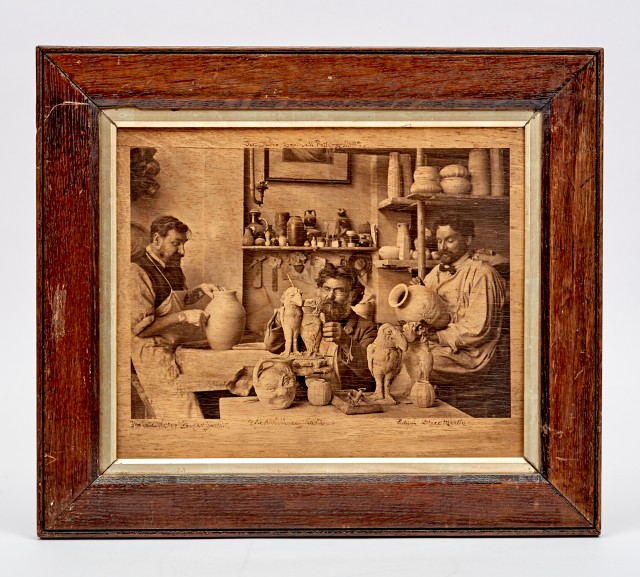Martin Brothers: Potters of the Avant-Garde
11/21/2022 Furniture & Decorative Arts

NEW YORK, NY -- The Martin Brothers manufactured pottery in London between 1873 and the 1920s. The brothers – Robert Wallace, Charles, Edwin and Walter – were pioneers of avant-garde ceramics. Their unusual pottery vessels often depicted birds, sea creatures and faces.
The Martin siblings were born in London between 1843 and 1860. In 1873, Robert Wallace launched his studio after studying at the Lambeth School of Art and the Royal Academy Schools. Four years later, the business relocated to Southall, Middlesex and began producing sculptures. Walter and Edwin worked at the relocated studios after they, too, studied at Lambeth. Walter became the throwing specialist, while Edwin focused on aquatic and floral motifs. The two brothers worked while Charles ran the shop.
Martinware pottery, as it came to be known, was primarily made with salt-glazed stoneware, a high-temperature firing method where the potter adds salt to the kiln to give the clay a rough surface. This European technique originally appeared in sixteenth- and seventeenth-century Gothic sculpture and architecture. Martinware's muted palette of browns, greens, grays and blues became the studio's signature. While many potters at the time focused on utilitarian forms, the Martin brothers embraced modernity and treated their craft as an intellectual endeavor. They gained popularity with collectors, continuing to work until the deaths of Charles, Edwin and Walter.
A group of Martinware highlights the Flower Family Collection of late 19th and early 20th century ceramics, featuring whimsical "Wally" birds and grotesques. While these imaginative works fell well outside the norm of typical English pottery wares, they enjoyed a small but devoted group of collectors. Appreciation for Martinware has only grown over time, and today these unique handmade works are recognized as a significant precursor to the studio pottery movement.
A clock case in the Gothic taste (lot 387) is an example of earlier and more conventional products from the firm. These cases served as canvases upon which founder Robert Wallace Martin incorporated gothic monsters into the ornament. Wallace gave his imagination full rein with his bird-form jars and grotesque figures, which he began creating around 1880.
Traditional English pottery may have inspired the bird-form jars (known as “Wally” birds after Wallace Martin). The jars bear quizzical, all-knowing or amused expressions. Over time, they became more anthropomorphic. They modeled some after characters like The Barrister (lot 386), The General, The Judge and the Serjeant. The Flower collection also includes a bird jar modeled by brother Charles Martin, who handled business affairs at the firm (lot 385). Although called tobacco jars by The Magazine of Art, 1882, these jars do not function as such, as they are not airtight, and only the very smallest of hands can reach inside.
The collection features two examples of grotesques (lot 383 and 384). While potentially functional as spoon warmers, toast racks, or jars, these works are first and foremost sculptures. The Magazine of Art compared them to Lewis Carroll’s 1887 nonsense poem The Hunting of the Snark: “We have a hundred young sculptors who will model you a Venus or an Adonis as soon as look at you; but who save Mr. Martin could give you a Boojum or a Snark in the round.” Wallace Martin lavished much attention on these grotesques, much to the consternation of his brothers, who were concerned this focus distracted Wallace from producing more lucrative pieces. His most extensive grotesque works included a fountain and many monsters and reptiles for Sir Frank Crisp’s grotto at Friar Park (bought by George Harrison in 1970).
The Flower collection includes a rare autotype, or photograph on wood, from 1912. The work depicts the Southall studio. Wallace is seated in front of Wally birds, flanked by brothers Walter and Edwin, surrounded by their distinctive wares.
Doyle+Design: Session II
Auction Thursday, December 8, 2022 at 10am
Exhibition Dec 3 - 5
A special section of the December 8 auction is devoted to The Flower Family Collection featuring a selection of rare ceramic objects created by the Martin Brothers.
.jpg)